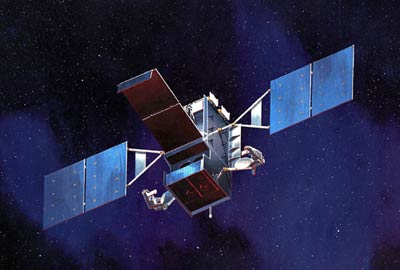Things are rough all over…by Dwayne Day
|
| It doesn’t take a genius to realize that each year, SBIRS is delayed by at least another year. And this is for a spacecraft that is essentially built. |
Take as an example the ongoing plight of SBIRS. In case you’re not familiar with military space acronyms, SBIRS (pronounced “sibirs”) stands for Space Based InfraRed System, which is the somewhat obtuse name for the US Air Force’s next generation missile warning satellites. SBIRS is supposed to replace the venerable Defense Support Program (DSP) missile warning satellites spotting missiles fired against the United States and its allies. The plan is for a constellation of three to four of these satellites to sit up in geosynchronous orbit and use advanced infrared sensors to stare down at the Earth and detect the heat generated by ballistic missiles fired from the ground or sea. The SBIRS sensors are supposed to be capable of locating the launch site of a missile to relatively high accuracy and also tracking the missile’s trajectory enabling it to be intercepted. SBIRS is also supposed to provide all kinds of useful intelligence, not only about missiles in flight, but also other thermal events such as battlefield explosions.
Two weeks ago the US Air Force announced that the first SBIRS launch will be delayed 12–18 months due to problems with the satellite’s software. This comes approximately 15 months after the Air Force announced a 15-month delay in launching the first satellite. SBIRS was initiated in 1996 with the first launch originally planned for 2004. It is now at least seven years behind schedule. It was originally supposed to cost $4.2 billion. As of last year, the Government Accountability Office estimated SBIRS to cost at least $10.4 billion. The last 15-month delay cost $414 million. Although nobody has put a pricetag on it yet, this latest delay will probably cost at least as much as the last one, pushing SBIRS’ cost close to $11 billion. It doesn’t take a genius to realize that each year, SBIRS is delayed by at least another year. And this is for a spacecraft that is essentially built. Some thermal and vacuum testing has already occurred. By the time that it actually flies, SBIRS could easily be a decade late and several hundred percent over budget. And by then, the United States could suffer a serious gap in missile warning capability. We can only hope that our adversaries are so nice as to not launch any missiles in the meantime.
Unfortunately, SBIRS is not an anomaly. There are several other major military space development programs that have suffered significant problems in recent years. The other major mess is the NPOESS weather satellite. Then there was the Future Imagery Architecture reconnaissance satellite canceled several years ago. Congress and the White House are currently engaged in a nasty dispute over the best method for recovering from that calamity. The Advanced Extremely High Frequency comsat has also suffered schedule and cost problems. And earlier this year the Secretary of Defense canceled the Space Radar system and the Transformational Satellite comsat program.
| If NASA doesn’t return humans to the Moon in the next decade or two, nobody will die, which is not the case for SBIRS, or NPOESS, or the next generation reconnaissance satellites. The stakes there are a little bit higher. |
Nor should one assume that this mess is simply confined to the military space program. Take a look at the F-35 Joint Strike Fighter program sometime, or the Air Force’s Russian tragedy of an effort to buy new tanker aircraft. Or look at the cost overruns of the Navy’s Littoral Combat Ship. Or at the Coast Guard’s Deepwater effort to buy new cutters; the first vessels cannot weather heavy seas, which tend to be the kind of seas that the Coast Guard operates in. Military procurement is no model to emulate.
By now you might have detected a common theme here: procurement of complex hardware is hard. Many projects are over-budget and behind schedule, not just at NASA, but everywhere.
Now certainly it is a good idea to keep asking if the people doing this can do better. But it is also worth asking if perhaps some of the intense criticism that the space activist community directs at NASA and its leadership is based upon expectations that are not realistic. If cost overruns and schedule delays are common in many high-technology procurement efforts, this indicates that there is a disconnect between the initial planning process and the actual implementation. It may also indicate that too often expectations and requirements are unrealistic.
But flogging one government agency and its leadership, while remaining oblivious to, or deliberately ignoring, similar issues plaguing other agencies, represents a failure of comprehension, or a misapplied view of the world. Perfection may exist in Heaven, but not down here. And if NASA doesn’t return humans to the Moon in the next decade or two, nobody will die, which is not the case for SBIRS, or NPOESS, or the next generation reconnaissance satellites. The stakes there are a little bit higher.
